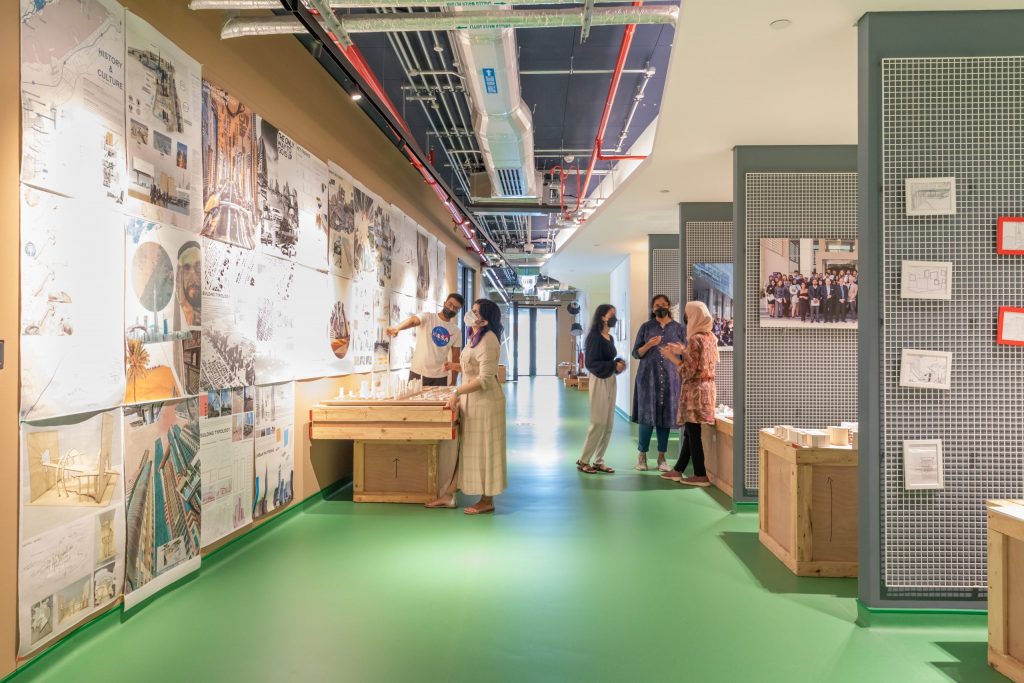School of Textiles and Design under the aegis of Heriot-Watt University has designed curricula in such a way that it fosters collaboration with industry professionals from local and international practices and provides exposure to real-world projects. This approach prepares students for real-world design work and equips them with practical skills and insights that are directly applicable to their future careers.
Heriot-Watt University’s School of Textiles and Design is dedicated to giving students access to cutting-edge workshops and resources that enables them to engage in experiential learning and apply design principles in realistic, practical settings.
Situated in the Middle East’s most dynamic city Dubai, the school places a high importance on diversity and inclusiveness, which creates a setting that values differences in viewpoints and encourages multidisciplinary cooperation.
![]()
Incorporating green spaces and highlighting natural light, the architectural arrangement creates an aesthetically stimulating environment that is believed to foster creativity and well-being.
The layout of the school’s campus is designed in such a way that promotes collaboration and cultivates creativity among both students and faculty.

Photo: School of Textiles and Design
One key aspect is the intentional layout that encourages spontaneous interactions and idea exchange. As per the industry experts, shared spaces, such as lounges, kitchens, and break areas are strategically placed to serve as informal meeting points.
The common spaces plays a crucial role in promoting socialisation and well-being among employees, as they provide the staff a means to interact, collaborate informally, and take breaks from their workstations. This social interaction can foster a sense of community and belonging, leading to improved morale and job satisfaction.

Photo: School of Textiles and Design
Other common areas, such as lounges and rooms designated for group work, are designed to challenge traditional divisions and promote dialogue and cooperation between people with varying backgrounds or specialisations.
Meeting Changing Needs
The institution’s design layout is planned in such a way that it will continue to evolve to meet changing educational and industry needs. An example of that is the incorporation of flexible and adaptable spaces that allow for dynamic use according to varying needs.
The school's classrooms are furnished with moveable furniture and interactive technology to accommodate a variety of teaching pedagogies, rather than being restricted to conventional settings.

Photo: School of Textiles and Design
The institute predicts that in order to support a variety of educational pedagogies and cooperative initiatives, its adaptable and modular learning environments will become more and more important.
“The design and architecture of our campus will continue to evolve to meet changing educational and industry needs,” added Alkawadri.
An example of that is the incorporation of flexible and adaptable spaces that allow for dynamic use according to varying needs. Classrooms are not confined to traditional setups; instead, they are equipped with movable furniture and interactive technology to support diverse teaching methods.
![]()
This adaptability extends to faculty offices and meeting rooms, fostering a sense of fluidity in academic activities.
The campus features a LEED Gold accredited building, where sustainable design principles play a crucial role, utilising eco-friendly materials and energy-efficient systems. This aligns with the growing emphasis on environmental consciousness within the design and textile industries.
These arrangements are particularly helpful in organising different activities we implement in the design studio, such as presentations, group discussions, collaborative projects, or individual studies. This adaptability extends to faculty offices and meeting rooms, fostering a sense of fluidity in academic activities.
Industry Focused Curriculum
Through a range of initiatives, including workshops, industrial contests, guest lectures, seminars, and contests, the institute has integrated professional experiences into the curriculum.
Through this variety of contacts, students get a realistic perspective on the opportunities and challenges they will face in their sector.
![]()
This hands-on experience enhances their technical and creative abilities and develops the critical thinking and problem-solving abilities required for success in the quickly evolving design field by exposing students to contemporary industry practices and standards.
Furthermore, the incorporation of practical experiences and exposure to real-world projects into our educational programs fosters professional networking and creates avenues for future career advancement. It also promotes a smooth transition between the professional and academic spheres.
With this method, students get practical skills and insights that they may use immediately in their future employment while also being prepared for real-world design work.
Incorporating Cutting-edge Technologies
By incorporating cutting-edge technologies such as virtual reality (VR), augmented reality (AR), and interactive screens into their teaching, educators can keep up with the latest advancements in technology and innovation while enabling students to explore previously unattainable places and scenarios, such as historical sites or scientific simulations.
These technologies offer new, interactive ways to study and experience knowledge outside of standard teaching methods, helping to make complicated subjects more approachable.
The school is dedicated to offering cutting-edge specialist workshops and facilities that enable students to get practical application of design principles and engage in experiential learning.
Photo: School of Textiles and Design
Its state-of-the-art labs are furnished with sophisticated equipment and instruments that let students conduct experiments with different materials and methods under the supervision of knowledgeable staff members.
The school also has state-of-the-art CAD and 3D modeling tools, allowing students to investigate the nexus between traditional craftsmanship and digital innovation.
The school prioritises communication design through dedicated workshops and facilities. Our Communication Design Studio provides students with access to industry-standard software, enabling them to develop visual communication skills, including photography, graphic design, branding, and multimedia storytelling.
![]()
“Our cutting-edge labs are equipped with advanced machinery and tools allowing students to experiment with various materials and techniques under the guidance of experienced faculty. The school is also equipped with the latest software for computer-aided design (CAD) and 3D modelling, enabling students to explore the intersection of traditional craftsmanship with digital innovation,” she added.
February 2024


